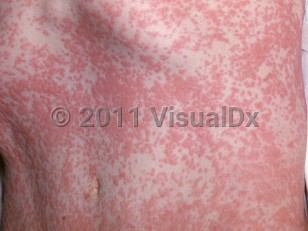Exanthematous drug eruption in Adult
Alerts and Notices
Important News & Links
Synopsis

EDE is most commonly seen with the use of antibiotics (penicillins and sulfas), allopurinol, phenytoin, barbiturates, chlorpromazine, carbamazepine, gold, d-penicillamine, captopril, naproxen, and piroxicam, but many other drug culprits have been reported, including chemotherapeutic, biologic, and immunotherapeutic (checkpoint inhibitor) agents.
Codes
L27.0 – Generalized skin eruption due to drugs and medicaments taken internally
SNOMEDCT:
238814003 – Maculopapular drug eruption
Look For
Subscription Required
Diagnostic Pearls
Subscription Required
Differential Diagnosis & Pitfalls

Subscription Required
Best Tests
Subscription Required
Management Pearls
Subscription Required
Therapy
Subscription Required
Drug Reaction Data
Subscription Required
References
Subscription Required
Last Updated:11/01/2022
 Patient Information for Exanthematous drug eruption in Adult
Patient Information for Exanthematous drug eruption in Adult- Improve treatment compliance
- Reduce after-hours questions
- Increase patient engagement and satisfaction
- Written in clear, easy-to-understand language. No confusing jargon.
- Available in English and Spanish
- Print out or email directly to your patient


